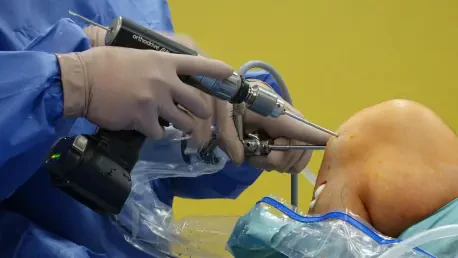Imagine stepping into a hospital where a computer can detect a hairline fracture in an X-ray with greater speed and accuracy than a veteran physician, instantly flagging issues that might otherwise be missed, and transforming the way orthopedic care is delivered. This isn’t a distant dream but a tangible reality unfolding in the field of orthopedics, driven by the remarkable advancements in artificial intelligence (AI). This technology is fundamentally reshaping the approach to diagnosing and treating musculoskeletal conditions, whether it’s a broken bone, a deteriorating joint, or a complex spinal issue. Far from being just another tech buzzword, AI stands as a transformative force, promising unprecedented precision, tailored patient care, and a significant reduction in surgical errors. This article delves deep into the ways AI is revolutionizing orthopedic care, exploring its applications in smarter imaging, enhanced diagnostics, robot-assisted surgeries, and personalized treatment plans. It also examines the immense potential alongside the current challenges that hinder seamless integration into everyday medical practice. By uncovering these developments, the goal is to highlight why AI is fast becoming an indispensable ally for orthopedic specialists and patients seeking better outcomes.
The Evolution of AI in Orthopedic Medicine
The journey of AI in healthcare, particularly in orthopedics, reflects a remarkable evolution from rudimentary algorithms in the mid-20th century to today’s sophisticated systems powered by machine learning and deep learning. These advanced tools are now capable of analyzing intricate medical images, predicting patient outcomes, and guiding critical surgical decisions with astonishing accuracy. In the realm of musculoskeletal care, which deals with the complexities of bones, joints, and connective tissues, AI’s ability to process vast datasets has opened new frontiers. Hospitals are increasingly adopting these technologies to address diagnostic errors, a pressing concern given that preventable medical mistakes contribute to over 250,000 deaths each year in the United States. By catching subtle anomalies that might escape human observation, AI acts as a vital support system for clinicians under pressure. However, integrating these innovations into diverse clinical settings poses significant challenges, from ensuring equitable performance across patient demographics to overcoming technical limitations. The following sections explore how AI is making a tangible impact, starting with one of its most groundbreaking applications: medical imaging.
The rise of AI in orthopedics is closely tied to the exponential growth in data availability and computational power, which have enabled the technology to tackle highly specialized challenges. Unlike earlier iterations that struggled with nuanced medical tasks, modern AI systems can interpret the biomechanical intricacies of the human body with precision. This shift has moved AI from experimental labs to real-world hospital settings, where it supports doctors in reducing errors during diagnosis and treatment planning. For instance, identifying minute fractures or planning intricate surgeries now benefits from AI’s data-driven insights, often surpassing traditional methods in consistency. Yet, the road to widespread adoption is not without obstacles, as issues like data diversity and system reliability continue to demand attention. Ensuring that AI tools are accessible and effective for all patients, regardless of location or background, remains a critical focus. As this technology continues to evolve, its role as a reliable partner in orthopedic care is becoming increasingly clear, setting the stage for deeper exploration into specific applications.
Enhancing Diagnostics Through AI-Powered Imaging
In the domain of orthopedic imaging, AI has emerged as a game-changer, transforming how X-rays, MRIs, and CT scans are interpreted. Leveraging deep learning frameworks such as convolutional neural networks, these systems can detect minute details in images that might elude even the most experienced radiologists. For example, AI can segment cartilage or bone structures in MRI scans within seconds, often achieving accuracy rates exceeding 85%. This capability is not merely about efficiency; it enables early identification of degenerative conditions like osteoarthritis, allowing for timely interventions that can delay or prevent severe outcomes. As a result, patients benefit from quicker diagnoses and more informed treatment strategies, while clinicians gain a powerful tool to support their expertise. The potential to revolutionize diagnostic workflows through such precision is immense, particularly in high-pressure environments where time and accuracy are paramount.
Despite these advancements, AI in imaging faces notable limitations that temper its promise, particularly as many models are trained on specific datasets that may not account for variations in equipment or patient demographics, leading to inconsistent performance across different settings. Without standardized evaluation metrics, trusting these tools universally across hospitals becomes challenging. Additionally, the dependency on high-quality images means that poorer scans can undermine results, a significant issue in under-resourced areas. Nevertheless, the prospect of AI democratizing access to top-tier diagnostics, especially in remote or underserved regions, remains compelling. If these hurdles can be addressed through broader data collection and refined algorithms, AI could redefine how orthopedic imaging supports patient care on a global scale, ensuring that early detection becomes a reality for more individuals.
Precision in Diagnosis: AI’s Diagnostic Breakthroughs
AI’s impact on diagnosing orthopedic conditions marks a significant leap forward, addressing everything from common fractures to rare developmental disorders. In fracture detection, AI models analyzing X-rays often achieve accuracy rates above 90%, matching or even surpassing the performance of seasoned specialists. This is particularly crucial in busy clinical settings where subtle breaks can be overlooked due to complex imaging angles or staff fatigue. Such precision reduces the likelihood of misdiagnosis, ensuring patients receive prompt and appropriate care. Moreover, the ability of AI to maintain consistency across countless cases offers a reliability that human assessment sometimes lacks, potentially transforming emergency rooms and outpatient clinics into hubs of diagnostic excellence.
Beyond fractures, AI excels in identifying conditions like developmental dysplasia of the hip in infants, automating ultrasound interpretations with tools like DDHnet that boast near-perfect precision. This drastically cuts down diagnosis times, often to mere seconds, enabling faster treatment and better long-term outcomes, especially in regions lacking specialized pediatric care. Similarly, for soft tissue injuries such as knee ligament tears, AI analyzes MRIs with exceptional detection rates, though it struggles with atypical or complex presentations. In osteoarthritis, automated grading of severity and joint space measurement supports early intervention, a critical factor in managing chronic pain. However, challenges like inconsistent image quality and limited training data persist, hindering universal application. Addressing these gaps could position AI as a cornerstone of diagnostic accuracy, fundamentally altering how musculoskeletal conditions are identified and managed.
Surgical Innovation: AI and Robotics in the Operating Room
AI is redefining orthopedic surgery through integration with robotic systems and real-time navigational aids, pushing the boundaries of precision in medical procedures. In operations like hip and knee arthroplasties, AI-driven 3D simulations allow for meticulous preoperative planning, ensuring implants are placed with exacting accuracy. Robotic platforms, such as those providing haptic feedback, assist surgeons in making precise cuts, leading to reduced recovery times and less postoperative discomfort for patients. Studies indicate that such technology can achieve near-perfect alignment even in complex deformities, a feat that traditional methods often struggle to match. This level of accuracy not only enhances surgical outcomes but also minimizes the risk of complications, offering a glimpse into a future where every operation is optimized for success.
However, the adoption of AI in surgery is not without its constraints, as the evidence supporting these innovations often stems from limited studies lacking long-term data. Variability in surgical protocols across institutions further complicates standardization, while the high cost of robotic systems restricts access for many hospitals, particularly in resource-limited settings. Additionally, certain aspects of surgery, such as manual adjustments in shoulder arthroplasty, still require significant human input, sometimes extending operative times during the learning phase. Despite these barriers, the precision and personalization AI brings to the operating room signal a transformative shift. Continued research and broader implementation could eventually make AI-assisted surgeries a standard, ensuring safer and more individualized interventions for patients worldwide.
Tailoring Care: AI in Personalized Treatment Plans
AI’s ability to personalize orthopedic treatment plans represents a significant stride toward patient-centered care, leveraging predictive analytics to anticipate individual needs. By analyzing vast datasets, AI models can forecast risks such as postoperative complications or even opioid dependency following joint replacements, enabling proactive management strategies. For athletes, algorithms predict injury risks like ACL tears with accuracy rates exceeding 90%, guiding preventive measures that could extend careers. In spinal surgeries, these tools help anticipate outcomes, allowing clinicians to provide more accurate preoperative counseling. Such tailored approaches ensure that treatments align closely with each patient’s unique profile, potentially improving satisfaction and recovery rates across diverse conditions.
Yet, the path to fully personalized care via AI is fraught with challenges, particularly around model transparency and applicability. Many predictive systems operate as opaque mechanisms, leaving clinicians uncertain about the basis for their recommendations, which erodes trust. Furthermore, these models often fail to generalize across varied populations, limiting their utility in diverse clinical contexts. The lack of clarity and adaptability means that while the concept of individualized treatment is promising, its practical impact remains constrained. Overcoming these issues through more interpretable algorithms and inclusive data collection is essential to ensure that AI can deliver truly customized care. As these barriers are addressed, the vision of treatments designed specifically for each patient’s circumstances could become a widespread reality, reshaping orthopedic practice.
Speeding Recovery: AI in Intelligent Rehabilitation
Postoperative recovery is a critical phase in orthopedic care, and AI is playing an increasingly vital role through intelligent rehabilitation solutions. Advanced rehabilitation robots, powered by AI, replicate natural human movements to assist patients in regaining strength in their limbs after surgery. Soft exoskeletons, for example, can reduce muscle strain by up to 43% during activities like hip flexion, accelerating the healing process. These technologies provide consistent support that adapts to patient progress, offering a level of precision and customization that traditional rehab methods often lack. By enhancing the effectiveness of recovery programs, AI helps patients return to daily activities sooner, reducing the physical and emotional toll of prolonged rehabilitation.
In addition to hardware, digital platforms such as smartphone apps are harnessing AI to transform recovery into a more accessible and engaging experience. These tools track progress after procedures like knee replacements, delivering personalized exercise plans directly to patients’ devices, often allowing rehab to continue at home. However, many of these innovations remain in early testing phases, lacking the large-scale studies needed to confirm their effectiveness across broader populations. Cost also poses a significant barrier, as high-tech rehabilitation options are not yet affordable for all clinics or individuals. Despite these limitations, the potential for AI to streamline and enhance recovery is evident. With further validation and cost reductions, these tools could redefine postoperative care, making rehabilitation more efficient and tailored to individual recovery journeys.
Advancing Therapies: AI in Orthopedic Drug Development
AI’s influence extends beyond clinical care into the realm of drug development for orthopedic conditions, accelerating the discovery of new therapies. Cutting-edge tools like AlphaFold predict protein structures with remarkable accuracy, unveiling potential targets for treatments addressing bone and joint diseases. Specialized platforms streamline the identification of drug candidates, slashing timelines from years to months for conditions such as fibrosis. This rapid pace could translate into faster availability of innovative therapies, offering hope to millions suffering from chronic musculoskeletal issues. The ability to expedite research in this manner underscores AI’s potential to address unmet medical needs within orthopedics, providing a pathway to novel solutions where traditional methods fall short.
Nevertheless, the application of AI in drug development faces significant hurdles that temper its immediate impact, particularly in areas like orthopedic conditions where data is often scarce. This scarcity hampers the training of robust models capable of reliable predictions. Additionally, many AI systems struggle with interpretability, leaving researchers unable to fully understand or trust the outcomes, which slows collaboration with clinical experts. The complexity of translating computational insights into viable drugs further complicates progress, requiring extensive validation. Despite these challenges, the promise of AI to revolutionize therapeutic development remains strong. With improvements in data availability and model transparency, this technology could usher in a new era of targeted treatments, significantly enhancing the quality of life for those with debilitating orthopedic conditions.
Navigating Data Obstacles in AI Implementation
One of the most formidable challenges to AI’s integration into orthopedics lies in the realm of data quality and diversity, as many AI tools are developed using datasets from single institutions that often fail to represent the wide array of patient demographics and clinical scenarios encountered globally. Such narrow data foundations can lead to biased or inaccurate outputs, undermining the reliability of AI applications in varied settings. If models cannot account for differences in ethnicity, age, or socioeconomic factors, their effectiveness is severely limited, potentially exacerbating disparities in care. Addressing this issue requires a concerted effort to build more comprehensive datasets that reflect the true spectrum of patient experiences, ensuring equitable outcomes across all populations.
Compounding the data challenge is the issue of subjectivity in labeling medical images or clinical outcomes, which introduces inconsistencies that erode model reliability. Without standardized protocols for data collection and evaluation, even the most advanced AI systems risk producing erratic results, particularly in complex orthopedic cases. Collaborative initiatives across hospitals and regions offer a potential solution, enabling the creation of richer, more inclusive data pools that enhance the robustness of AI tools. Establishing universal guidelines for data handling could further mitigate variability, fostering trust in AI’s capabilities. Until these data obstacles are overcome, the transformative potential of AI in orthopedics will remain partially unrealized, highlighting the urgent need for systemic improvements in how information is gathered and utilized.
Addressing the Transparency Gap in AI Systems
A critical barrier to the widespread adoption of AI in orthopedics is the lack of transparency in how these systems operate, often referred to as the “black box” problem. Clinicians are understandably hesitant to rely on tools that do not clearly explain their diagnostic or treatment recommendations, especially in high-stakes scenarios like surgical planning. This opacity not only undermines trust but also poses risks, as over-reliance on unexplained outputs could lead to errors, while outright dismissal of AI might stifle innovation. The need for clarity in decision-making processes is paramount, as understanding the rationale behind AI suggestions could significantly enhance their integration into clinical workflows, bridging the gap between technology and medical practice.
Developing AI models that provide interpretable results in accessible language is a crucial step toward overcoming this transparency gap, enabling doctors to critically evaluate AI outputs. By combining technological insights with their own expertise, physicians can achieve better patient outcomes. Furthermore, transparent systems could reduce the fear of over-dependence, ensuring that AI serves as a supportive tool rather than a replacement for human judgment. Until these models are refined to offer clear explanations, their acceptance in orthopedic settings will remain limited. Prioritizing research into explainable AI holds the key to fostering confidence among healthcare providers, ultimately facilitating a smoother transition of these technologies into everyday use and maximizing their potential to improve care.
Validating AI for Real-World Clinical Impact
Even with impressive results in controlled environments, AI tools in orthopedics must undergo rigorous real-world testing to demonstrate their practical value. Many current studies on applications like fracture detection or surgical planning lack data from multiple hospitals or extended follow-up periods, raising questions about their performance outside idealized settings. Only a small percentage of these tools have been validated across diverse regions or patient cohorts, leaving uncertainty about their adaptability to the complexities of actual clinical practice. Without comprehensive testing, the risk remains that AI might underperform in unpredictable scenarios, diminishing its perceived reliability among healthcare professionals and patients alike.
To bridge this validation gap, large-scale, multi-center trials are essential to assess how AI tools handle the variability inherent in real-world medical environments. Such studies would provide critical insights into performance across different equipment, protocols, and demographic groups, ensuring that tools are not only effective but also equitable. For instance, pediatric-specific AI applications often lack regulatory approval, restricting their clinical use despite promising early results. Robust validation efforts could accelerate the path to certification and adoption, solidifying AI’s role as a dependable asset. Until these gaps in evidence are addressed, AI risks being viewed as a theoretical advancement rather than a proven solution, underscoring the need for sustained investment in practical, long-term evaluation.
Tackling Ethical and Legal Complexities of AI Use
The integration of AI into orthopedics also brings to the forefront a host of ethical and legal considerations that must be navigated carefully. Patient data privacy stands as a primary concern, with questions surrounding how sensitive information used to train AI models is safeguarded against breaches or misuse. Additionally, the potential for algorithmic bias poses a risk of unequal treatment, where certain demographic groups might receive suboptimal care due to unrepresentative data. These issues demand stringent protocols to protect patient rights and ensure fairness, as any lapse could undermine public trust in AI-driven healthcare solutions. Establishing robust safeguards is vital to maintaining the integrity of these technologies in clinical settings.
Equally pressing are the legal ambiguities surrounding accountability for AI-driven decisions in orthopedics, where uncertainty persists about who is responsible if a tool provides an incorrect recommendation leading to patient harm. Determining responsibility—whether it lies with the developer, the clinician, or another party—remains unclear. This uncertainty can deter adoption, as healthcare providers grapple with the fear of liability in uncharted territory. Clinicians themselves express caution, wary of over-relying on technology at the expense of their professional judgment. Crafting clear legal frameworks and ethical guidelines is imperative to balance innovation with accountability. Resolving these concerns will be crucial in paving the way for AI to become a trusted component of orthopedic care, ensuring that its benefits are realized without compromising safety or equity.
Building the Future of AI in Orthopedic Care
Reflecting on the strides made, it’s evident that AI has already begun to redefine orthopedic practice by enhancing diagnostic accuracy, surgical precision, and personalized treatment approaches. The remarkable achievements in imaging analysis, where subtle conditions are detected with unprecedented speed, underscore a shift toward earlier interventions. Robotic assistance in surgeries has proven its worth by minimizing errors and speeding recovery, while predictive models offer tailored insights into patient risks. Even in rehabilitation and drug development, AI has laid the groundwork for more effective and rapid solutions, addressing long-standing challenges in patient care. These milestones, achieved through relentless innovation, have set a strong foundation for what is to come, demonstrating the profound impact of technology on musculoskeletal health.
Looking ahead, the focus must shift to actionable steps that build on past progress and address lingering hurdles in the development of AI tools for medical use. Prioritizing the creation of diverse, high-quality data platforms through global collaboration can ensure AI tools are inclusive and effective for all patients. Developing interpretable models that demystify decision-making processes will foster trust among clinicians, encouraging broader adoption. Additionally, investing in large-scale, multi-center trials to validate AI in real-world settings remains essential to confirm reliability across varied contexts. Strengthening ethical and regulatory frameworks to protect privacy and ensure fairness will further solidify confidence in these tools. By pursuing these strategies, the orthopedic field can fully harness AI’s potential, transforming it from a promising innovation into a cornerstone of modern medical practice that consistently improves patient outcomes.









